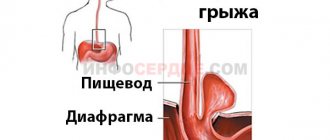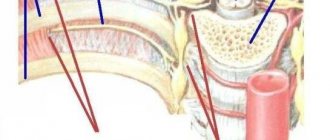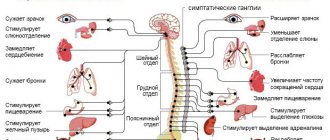Neurosis of the larynx and pharynx does not exist as a nosological unit. This is what is usually called persistent sensations: a lump in the throat, convulsions. Doctors at the Yusupov Hospital conduct a comprehensive examination of patients who complain of tension in the throat muscles and establish the cause and type of neurosis.
Global or partial changes in sensitive receptors of the mucous membranes, which cause pharyngeal neurosis, occur as a result of impaired neurotransmitter communication and infectious diseases. The most common cause of laryngeal neurosis is osteochondrosis of the cervical spine. A lump in the throat with neurosis can be felt due to the influence of the following factors:
- Inflammatory diseases of the ENT organs;
- Atrophy of cells of the laryngeal mucosa;
- Disorders of the central nervous system;
- Overwork.
Patients who have symptoms of throat neurosis are treated at the Yusupov Hospital with modern medications and methods of psychotherapy. Doctors individually select a treatment regimen. Medical staff respects the psychological problems of patients.
Types of pharyngeal neurosis
There are 3 forms of pharyngeal neurosis:
- Anesthesia;
- Hyperesthesia;
- Paresthesia.
Anesthesia of the pharynx is manifested by a decrease or absence of throat sensitivity and impaired swallowing. The disease develops in patients suffering from brain tumors, syphilis, and hysterical neurosis. The patient may aspirate food or saliva into the airway and develop aspiration pneumonia.
Pharyngeal hyperesthesia is accompanied by an increase in the pharyngeal and gag reflex. The patient has a cough and tries to cough up non-existent phlegm. This type of throat neurosis can develop after severe stress or a chronic disease of the pharynx or larynx. Patients experience a spasm, a sore throat, and a sore throat. He may feel a “scratching” sensation on the surface of the larynx.
Pharyngeal paresthesia occurs under stress. Patients feel soreness, itching and a “lump” in the throat. Women who are in menopause, impressionable and irritable people are susceptible to the disease.
The main reasons for the sensation of a pulse in the throat
Few people notice exactly how their heart works. You can feel its beating only if you put your hand on your chest or try to feel the pulse. However, sometimes a palpitation in the throat area can be felt without these manipulations.
An alarming symptom may occur for the following reasons:
Panic attacks
Every person knows this unpleasant feeling. This condition occurs in people when experiencing a stressful situation. In extreme cases, a panic attack develops when a person is completely calm. If the cause of the pulse in the throat lies in this condition, then symptoms such as sweating, trembling of the limbs and dry mouth will appear in parallel.
Symptoms of throat neurosis in adults and children
Throat neurosis is characterized by stable symptoms that differ depending on the type of disease. The main manifestations of the disease are tissue numbness and weakening of the swallowing reflex. The disease is accompanied by severe pain throughout the body. Patients may experience increased sensitivity of the hard tissues of teeth.
Throat neurosis is manifested by the following main symptoms:
- Feeling of lack of oxygen even after taking a deep breath;
- Feeling of a lump in the throat that does not go away after drinking liquid;
- Dryness in the larynx;
- Intense thirst;
- Bronchial spasm, which is accompanied by a gag reflex and is not relieved by bronchodilators;
- Sore throat, itching, sore throat, worsening at the moment of greatest irritation;
- Pain in the neck;
- Shooting pain in the ear.
Symptoms of throat neurosis are aggravated when a person is in a dusty or smoky place. An increase in reflex reactions leads to a gag spasm during a hacking dry cough.
Symptoms of throat neurosis intensify with excitement, irritability, psycho-emotional lability, and a migraine attack. Patients' mental and physical activity decreases.
A lump in the throat with neurosis provokes the occurrence of additional symptoms:
- Mood swings;
- Disturbances in sleep and wakefulness;
- Decreased appetite;
- Hypochondria;
- Manifestations of depression;
- Fear of suffocation.
It is especially difficult to diagnose throat neurosis in children, since they are susceptible to colds, the symptoms of which are similar in symptoms to those of pharynx and larynx neurosis.
Under the influence of provoking factors, the function of the child’s immature nervous system is disrupted, which leads to the loss of neural connections between active cells of the mucous membrane of the upper respiratory tract. Children are psycho-emotionally immature. They react sharply to all irritating factors of a psychogenic nature.
For this reason, throat neurosis in children is often accompanied by somatic pathology. The child's sleep may be disturbed and emotionality may increase. Children can swallow whole pieces of food, which leads to disruption of the digestive system. Sometimes children suffering from throat neurosis develop hoarseness or aphonia (complete absence of voice while maintaining whispered speech).
What does it mean to feel a palpitation in your throat?
A person who has no health problems is unlikely to feel a heartbeat somewhere in the throat area.
In addition, he certainly will not have thoughts about the fact that his organ has moved to another place, which is why such a strange sign arises. Experts identify several conditions that may be accompanied by a heartbeat in an unusual location. If they are the cause of the illness, then everything is fine with the human body. Do not worry about your own health if you feel your heart pounding in your throat in the following situations:
- After intense physical activity that lasted for a long time.
- When feeling intense fear or while expressing another similar emotion.
- When experiencing severe stress.
As a rule, if these conditions lead to discomfort, it will soon go away. It is enough for a person to simply calm down and relax as much as possible.
Sometimes a strange symptom is accompanied by a sharp jump in body temperature. In this situation, we can talk about possible disturbances in the functioning of the cardiovascular system. A knock in the throat will mean a special reaction of the body to a change in the usual temperature.
In all other cases, doctors will associate discomfort with the development of a pathological process that reveals itself as this symptom. To identify it, you will need to conduct a series of diagnostic studies.
Diagnosis of throat neurosis at the Yusupov Hospital
In order to establish the cause of throat neurosis, doctors at the Yusupov Hospital conduct a comprehensive examination of the patient. Using radiography of the cervical spine, osteochondrosis is detected or excluded. More accurate information is obtained after a computed tomography scan of the spine. Patients undergo laboratory tests (general and biochemical blood tests, thyroid hormone levels).
In order to exclude the organic nature of the disease, doctors perform magnetic resonance and computed tomography of the throat. A comprehensive examination includes Doppler ultrasound of the vessels of the brain and neck, and electromyographic study. Patients are consulted by an otolaryngologist, neurologist, vertebrologist, and psychotherapist.
Difficulty swallowing and lump in throat
Impaired swallowing is a sign of severe structural changes in the body, when a lump in the throat indicates stress or inflammatory diseases of the oropharynx. Specialists from the ENT Center clinic in Moscow will conduct an examination and prescribe the necessary treatment.
Impaired swallowing (dysphagia) and a lump in the throat can signal serious illnesses that require immediate treatment, or they can be a sign of simple fatigue. The specialists of our ENT Center clinic in Moscow will help you determine the cause and cope with the discomfort.
Causes and their symptoms
In infants, swallowing disorders most often have a congenital nature. Provoking factors include cerebral palsy, esophageal stenosis, gastroesophageal reflux disease, and congenital facial defects. In the latter cases, treatment is carried out surgically; in others, the use of special mixtures or tube feeding is required.
It is also necessary to differentiate between true dysphagia and pseudodysphagia. The first is accompanied by a violation of the act of swallowing, when the second only causes a sensation of a lump in the throat, making it difficult for food to move through the esophagus.
True dysphagia
True dysphagia is associated with the following reasons:
- Catarrhal processes in the esophagus, oropharynx. Inflammation causes dysphagia, hyperthermia, deterioration of general condition, a feeling of suffocation and a lump in the throat.
- Thyromegaly is associated with the growth of the thyroid gland, which compresses the esophagus, impairing swallowing function.
- A stroke is accompanied by difficulty swallowing, drooling, coughing, weakening of the muscles of the face and body, impaired coordination of movements, and speech function.
- Parkinson's disease. Swallowing disorders are associated with degerant processes in the central nervous system, which leads to damage and weakening of the muscles of the oropharynx, tremors of the limbs, and impaired vestibular function.
- Multiple sclerosis. The problem can be recognized by tremors of the limbs, muscle weakness, disturbances in chewing, swallowing and speech activity.
- Achalasia is associated with insufficient reflex weakening of the lower esophageal sphincter. The pathology is characterized by food dysphagia, regurgitation of undigested food, chest discomfort, flatulence, heaviness in the stomach, nausea and vomiting.
- Benign and malignant tumors of the neck, mediastinum, head. As the tumors grow, they can put pressure on the blood vessels, trachea and esophagus, disrupting the swallowing process and causing weight loss, chest pain, and suffocation.
Pseudodysphagia
Most often, swallowing dysfunction is functional. A person feels a lump in the throat, but there are no structural changes in the body. The cause may be stress or emotional overstrain (psychosomatics). However, most often organic causes of discomfort are caused by infectious and inflammatory diseases of the oropharynx (tonsillitis, pharyngitis, laryngitis, peritonsillar abscess), which are accompanied by a lump and sore throat, increased body temperature, and general malaise. Diagnostics
Frequent disruption of the act of swallowing, the feeling of a lump in the throat should not be ignored, as it can lead to (choking while eating and food entering the respiratory tract - aspiration) inhalation of food. Aspiration provokes acute and chronic pathologies of the lungs, including suffocation with a fatal outcome.
To determine the cause of discomfort, you need to contact several specialists - a therapist, ENT specialist, gastroenterologist, neurologist, psychotherapist. Only a comprehensive examination will determine the true cause.
To obtain a clinical picture, the doctor collects anamnesis and prescribes:
- general clinical and biochemical blood test, blood test for thyroid hormones;
- radiography (MRI or CT as indicated) of the head, chest, throat, videofluroscopy;
- esophageal manometry, gastroscopy;
- Dopplerography of head and neck vessels;
- electromyographic study.
Treatment
Treatment of lump in the throat syndrome and dysphagia is complex and depends on the cause. Patients are prescribed:
- antiphlogistic, antibacterial, antiviral therapy in the presence of catarrhal processes in the ENT organs and gastrointestinal tract;
- antidepressants, antipsychotics, tranquilizers for the relief of neurotic disorders;
- hypnosis, cognitive behavioral therapy, individual and group rehabilitation for mental health disorders;
- reflexology, physiotherapy;
- breathing exercises, physical therapy.
In the presence of obstructive processes or tumors, surgery is prescribed to remove them, and in case of inoperable esophageal cancer, stenting is prescribed.
How to feed a patient
If the act of swallowing is impaired, but the reflex is preserved, it is important to maintain the ability to feed independently. The patient is recommended soft, semi-liquid and liquid meals, which are taken under the supervision of medical personnel or people caring for him. It is important to eat at regular intervals and reduce your portion size. Foods that irritate the mucous membrane should be excluded from the diet.
If swallowing function is not restored within three days, the patient is fed through a nasogastric tube.
The ENT Center offers a wide range of services, which allows not only to determine the cause of dysphagia and lump in the throat, but also to provide the necessary treatment within the walls of our clinic. To do this, we employ specialists of various profiles - otolaryngologists, endocrinologists, psychologists. You can get acquainted with our doctors and make an appointment with them on the clinic’s website.
Treatment of throat neurosis
Symptoms of neurosis of the pharynx and larynx disrupt the quality of life of patients. At the initial stage of the disease, it is performed on an outpatient basis. The patient is recommended to change his lifestyle, maintain the correct daily routine, alternate between wakefulness and sleep, go to bed on time, and get a good night's sleep. If the cause of neurosis is sleep, the symptoms of the disease disappear after several days of rest.
In the presence of an inflammatory process, anti-inflammatory therapy is carried out. A patient with throat neurosis is prescribed herbal sedatives. The selection of medications and dosage is carried out by a doctor. After several days of taking medications, the symptoms of neurosis of the pharynx and larynx disappear. If the patient feels a lump in the throat during neurosis, pureed liquid food is prepared for him, which does not irritate the mucous membrane of the pharynx. You should stop smoking, drinking alcohol, and eating spicy foods.
If the therapy is ineffective, doctors prescribe small doses of antidepressants in the presence of depression and asthenic syndrome. To treat throat neurosis, which manifests itself as hypochondria (constant worry about the possibility of contracting a serious illness), antipsychotics are used. If the cause of throat neurosis is a disease of the cervical spine, neurologists at the Yusupov Hospital treat it using medications, physiotherapeutic procedures and modern rehabilitation methods. In some cases, manual therapy is performed.
Psychotherapeutic techniques include hypnotherapy and cognitive behavioral therapy. Psychological correction techniques are aimed at teaching the patient effective ways to relax. Treatment has the following goals:
- Leading the patient to understand the true causes of the pathology;
- Identification of psychotraumatic factors;
- Eliminating them or learning to adapt to them.
Children suffering from neurosis of the throat and larynx are observed by several specialists: an otolaryngologist, a psychologist, a speech therapist (depending on age). Correct parental behavior increases the effectiveness of treatment. Most of the psychogenic factors that cause neuroses in children come from home.
Children with throat neurosis undergo restorative therapy, which includes vitamin complexes and mild sedatives. During the treatment of throat neurosis in a child, it is important to suppress obvious physical symptoms. When there is a sore throat, children are prescribed rinses, inhalations, absorbable tablets, and medications that increase the level of immunity. For infectious diseases, dekasan or trachysan are prescribed.
Psychotherapy for children involves classes on general development, training in relaxation techniques, which include breathing exercises. Babies receive a full body massage aimed at finding blocks and relaxing them. Psychotherapists recommend that parents change the psychogenic situation at home, reconsider their behavioral reactions and correct them. It is important that the child follows a daily routine. He needs to introduce healthy foods into his diet, enriched with vitamins and minerals.
A child with neurosis of the pharynx and larynx should be treated carefully. There is no need to scold him, but hysterics must be stopped immediately. With neurosis, a spasm of the throat is often observed. During an attack, it is necessary to help the child cope with the situation, calm him down, and explain how to breathe correctly.
Diagnostic methods
Doctors often see patients who complain of an unusual heartbeat somewhere in the throat. If a specialist does not have enough qualifications to study and treat this ailment, he can only recommend that the patient get rid of bad habits. The doctor will also prescribe a number of medications after reviewing the ECG results, which should help relieve the symptom.
Unfortunately, the above measures are not always sufficient to solve such a specific problem. The feeling of a heartbeat in the throat may indicate serious disorders that are detected only during a complete diagnosis of the patient. To see the full picture of the disease, the patient will have to visit several highly specialized specialists. They will prescribe appropriate tests for this case, which will be required to make a final diagnosis.
If you feel as if your heart is pulsating in your throat, you must undergo the following diagnostic procedures:
- Anamnesis collection. The patient must inform the doctor about his bad habits, as well as possible addictions to coffee and other similar drinks.
- Ultrasound examination of the heart and ECG.
- X-ray of the problem area.
- Ultrasound examination of the thyroid gland.
- Blood test for hormonal disorders.
- Radioisotope study of the thyroid gland.
Consultation with a psychologist may be required. You cannot do without it if the doctor suspects that the symptom is caused by panic attacks.
We recommend how to treat the feeling of suffocation in the throat.
Relieving throat muscle tension during neurosis
Tension of the throat muscles during neurosis causes breathing problems. In the complex treatment of neurosis of the pharynx and larynx, breathing exercises can give good results. It helps relieve spasm and tension in the respiratory muscles, restore breathing rhythm, reduce the dosage of medications, and speed up the healing process. You need to take an active short breath and a natural passive exhalation. The air should be inhaled through the nose, making a short, strong movement, and exhaled through the mouth.
The breathing movement and inhalation must coincide in time. The rhythm of breathing movements should correspond to the rhythm of the march. Breathing exercises for throat neurosis can be done standing, sitting or lying down. Their effectiveness improves in fresh air. To determine the cause and type of throat neurosis, exclude the organic nature of the disease and undergo a course of effective therapy, call the contact center of the Yusupov Hospital.











